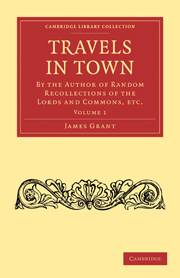CHAPTER V - THE BRITISH MUSEUM
Published online by Cambridge University Press: 29 August 2010
Summary
The British Museum is perhaps the most valuable of all our public institutions. It is every day rising more and more into importance, and is at the same time making a corresponding progress in public favour. It is situated near the east end of Great Russell Street, Bloomsbury. Reserving the Reading Room and Library of the institution for a separate chapter, I shall in the present case, after a few historical remarks, make some observations, and communicate some facts which are not generally known, respecting the rooms which are appropriated to the wonders of nature and art.
The building itself is one of great magnitude. On entering the gate, a spacious quadrangle presents itself. On the south side is an Ionic colonnade. Directly before you is the main building, while the two wings on either hand, between the gate and the entrance to the principal building, are appropriated as dwelling places for the officers of the institution. The main edifice was originally the mansion of the Duke of Montague, and was erected by Peter Puget, a native of Marseilles, who was brought over from Paris for the purpose. This was towards the close of the seventeenth century. The property which was called Montague House, was purchased in 1754 by the trustees of the British Museum from the heirs of the Duke of Montague, with the view of fitting it up for the reception and exhibition of the valuable library, manuscripts, and collection of curiosities in nature, art, and science, which had, the year before, been bequeathed to government by Sir Hans Sloane, for the benefit of the nation, on the payment of 20,000l. to his heirs and successors.
- Type
- Chapter
- Information
- Travels in TownBy the Author of Random Recollections of the Lords and Commons, etc., pp. 226 - 261Publisher: Cambridge University PressPrint publication year: 2010First published in: 1839

